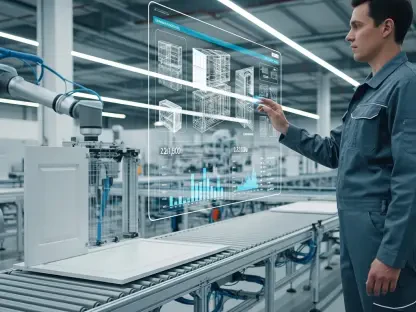In 2024, the manufacturing industry stands at a pivotal juncture, where the merging of legacy systems with modern technologies dictates the pace of progress. This landscape is influenced by a collaborative synergy among C-suite executives, IT, and OT (Operational Technology) professionals. Based on insights from the Zebra 2024 Manufacturing Vision Study, we explore the best strategies for navigating this evolving terrain.
The Balancing Act: Legacy Systems and New Technologies
Integration Challenges and Solutions
Manufacturers are uniquely positioned in their need to integrate new technologies with existing, often outdated, systems. This integration is not as simple as sidelining old technologies; it requires careful planning to ensure efficiency improvements without compromising customer experiences or failing to meet Service-Level Agreements (SLAs). The balancing act involves integrating advanced tools and software into the current operational framework, a task that demands both technical expertise and strategic foresight.
Successful implementation hinges on ensuring compatibility between modern innovations like AI and IoT with entrenched infrastructures. Manufacturers are increasingly deploying simple sensors and advanced analytics tools that are designed to coexist harmoniously with legacy systems. This strategy not only minimizes disruption but also allows for a smoother transition toward comprehensive digital transformation. The careful orchestration of these systems ensures that new technologies can integrate seamlessly into existing workflows, reducing the risk of operational hiccups and resistance from stakeholders.
Case Studies of Successful Integration
Case studies from the manufacturing sector vividly illustrate how incremental adoption can lead to significant advancements. Companies that have implemented sensor-based tracking and AI-driven analytics have reported substantial improvements in production efficiency and worker safety. These technologies act as proof of concept, demonstrating to stakeholders that even small-scale projects can deliver quick returns on investment. By focusing on incremental improvements, these firms have created a scalable template for broader automation efforts.
For example, a manufacturing plant specializing in automotive components deployed IoT sensors and data analytics to monitor machine health and predict maintenance needs. This initiative not only reduced unexpected downtime but also extended the life of existing equipment, thereby lowering costs. Another case study highlights a company in the food processing industry that utilized AI to optimize production lines, resulting in a 20% increase in output without additional labor. These success stories underscore the power of incremental advances in achieving substantial operational gains and fostering stakeholder confidence.
Collaboration Across C-Suite, IT, and OT
Importance of Unified Decision-Making
Effective digital transformation in manufacturing necessitates collaboration among C-suite executives, IT specialists, and OT professionals. Each group brings distinct priorities and expertise to the table, making unified decision-making crucial for the successful implementation of automation strategies. The shared goals of reducing waste, enhancing operational efficiency, and exceeding SLAs form the bedrock of these collaborative efforts. The integration of viewpoints from diverse domains ensures that all aspects of the transformation are robustly addressed.
Strategic meetings and cross-functional teams are often employed to facilitate communication and align objectives. The C-suite focuses on overarching business goals and ROI, while IT ensures these objectives are technically feasible and secure. Meanwhile, OT professionals bring practical insights about operational requirements and constraints, ensuring that new technologies can be effectively integrated into daily workflows. This multi-faceted approach guarantees that the transformation aligns with both strategic and operational imperatives, leading to more synchronized and impactful outcomes.
Examples of Successful Collaborative Efforts
Several manufacturers have successfully navigated the collaborative landscape by fostering a culture of open communication and strategic alignment. For instance, companies that have established cross-functional teams to oversee automation projects have experienced smoother implementations and higher success rates. These teams are responsible for ensuring every aspect of the digital transformation aligns with both technical capabilities and business objectives. The synchronization of efforts across departments reduces friction and accelerates the path to realizing automation benefits.
The Zebra 2024 Manufacturing Vision Study highlights numerous examples where collaborative decision-making has led to significant operational improvements. One notable case involves a pharmaceutical company that established a digital transformation task force comprising representatives from IT, OT, and the executive team. This task force successfully rolled out a new production tracking system that improved delivery timelines and reduced errors. These case studies serve as a testament to the power of unity in driving effective automation strategies and illustrate how cross-functional collaboration can result in tangible operational and financial benefits.
Focus on Incremental Automation and Quick Wins
Benefits of Incremental Automation
The path to effective automation often lies in incremental advancements rather than sweeping overhauls. By focusing on smaller projects with quick returns, manufacturers can build momentum for larger-scale transformations. These incremental projects also serve as valuable proof of concept, demonstrating the ROI and feasibility of more comprehensive digital initiatives. The approach of taking small, calculated steps helps in managing the inherent risks associated with digital transformations and ensures continuous progress without overwhelming the system.
Simple technologies like sensors, combined with advanced software analytics, can provide significant improvements in production efficiency and worker safety. These small-scale projects highlight the immediate benefits of automation, making it easier to secure stakeholder buy-in for more ambitious endeavors. For instance, deploying machine learning algorithms to optimize energy use can quickly reduce operational costs, providing tangible evidence of the technology’s value. These quick wins not only pay for themselves in a short period but also create a positive feedback loop that encourages further innovation and investment.
Proven Strategies for Achieving Quick Wins
Manufacturers looking to achieve quick wins should prioritize areas where automation can immediately impact efficiency and cost savings. Examples include deploying IoT devices for real-time monitoring and using AI to optimize production schedules. By starting with projects that offer immediate returns, companies can build a track record of success, strengthening the case for larger investments. These initiatives serve as a demonstration of the practical benefits of automation, making it easier to gain the necessary internal support and funding for future projects.
Additionally, investing in employee training can expedite the adoption of new technologies, ensuring the workforce is equipped to leverage these tools effectively. Training programs designed to familiarize employees with new automation tools not only improve user adoption but also empower workers to contribute to the optimization process. By aligning these smaller projects with broader strategic goals, manufacturers can create a sustainable pathway to comprehensive digital transformation. This methodical approach ensures that each step taken adds incremental value, paving the way for more significant, transformative changes down the line.
Addressing Labor and Space Constraints with Technology
Tackling Labor Shortages
Labor scarcity in the manufacturing sector presents a significant challenge, but effective automation can provide a viable solution. Technologies such as cobots (collaborative robots) and IoT devices can alleviate the burden on human workers, enhancing productivity without needing significant workforce expansions. Cobots, designed to work alongside human operators, can handle repetitive tasks, allowing employees to focus on more complex and value-added activities. This symbiotic relationship between human workers and cobots maximizes productivity and allows companies to scale operations without the pressures of labor shortages.
This collaborative approach also boosts productivity and enhances worker satisfaction by reducing task monotony. Implementing training programs for employees on how to work alongside these technologies further contributes to a seamless integration process. For example, a manufacturer might use cobots to assemble components while human workers handle quality control and problem-solving tasks. This approach not only optimizes labor use but also creates a more engaging and fulfilling work environment, which can improve overall job satisfaction and retention.
Optimizing Limited Space
In today’s complex manufacturing setting, preserving operational efficiency while embracing innovation is essential. Companies must not only optimize their current processes but also remain agile in adopting new technologies. This dual approach ensures they can meet market demands without compromising quality. A critical aspect involves seamless communication and collaboration between different departments. C-suite executives need to align their strategic vision with the technical insights provided by IT and OT teams. By fostering this synergy, companies can better anticipate challenges, leverage data-driven insights, and make informed decisions, thus driving sustainable growth and staying competitive in an ever-evolving market.









